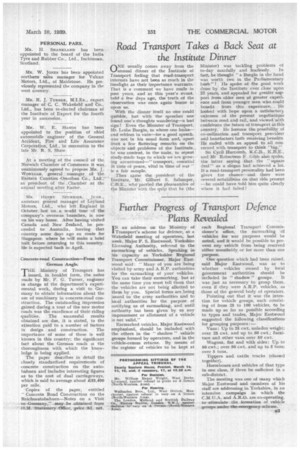Further Progress of Transport Defence Plans Revealed I N an address on the Ministry of
Page 37

If you've noticed an error in this article please click here to report it so we can fix it.
Transport's scheme for defence, at a Wakefield meeting of operators, last week, Major F. S. Eastwood, Yorkshire Licensing Authority, referred to the earmarking of vehicles. Speaking in Ms capacity. as. Yorkshire Regional. Transport Commissioner, Major Eastwood said: " Many of you are being visited by army and A.R.P. authorities for the earmarking of your vehicles. You can take their earmarking, but at the same time you must tell them that the vehicles are not being allotted to them by you. Special forms are being issued to the army authorities and to local authorities for the purpose of notifying us of earmarking, and until authority has been given by us any impressment or allotment of a vehicle is not valid."
Earmarked vehicles, Major Eastwood emphasized, should be included with the others in the " shadow " vehicle groups formed by operators, and in the vehicle-census returns. By, means of the register of vehicles to be kept at each Regional Transport Commissioner'e office, the earmarking 'Of vehicles for war purposes would be noted, and it would be possible to prevent any vehicle from being reserved either eneuitably or for more than one PmFuse=
One question which had been raised, said Major Eastwood, was as to whether vehicles owned by local government authorities should be included in "shadow" groups. It was just as necessary to group them, even if they were A.R.P. vehicles, as those of. the general body of operators.
Pointing out that it was the intention for vehicle groups, each consisting of from 25 to 100 vehicles, to he made up so far as possible according to types and trades, Major Eastwood suggested the following classifications for grouping purposes:— Vans : Up to 25 cwt. unladen weight; over 25 cwt. and up to 50 cwt.; furniture and other vans over 50 cwt: Wagons, flat and with sides: Up to 50 cwt.; over 50 cwt. and up to 5 tons; over 5 tons.
Tippers and cattle trucks (classed together).
Horseboxes and vehicles of that type in one class, if there be sufficient in a sub-district.
The meeting was one of many which Major Eastwood and members of his staff are. addressing. in Yorkshire, in an intensive campaign in which. the C.M.U.A. and A.R.Cb are co-operating, to stimulate the formation of vehicle groups under the emergency scheme.




























































































